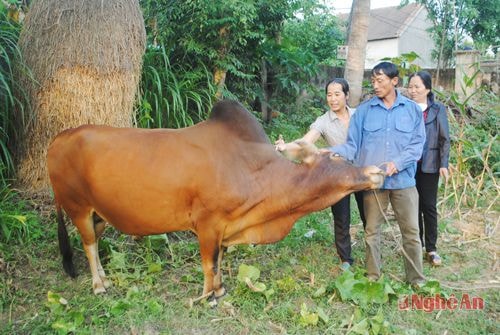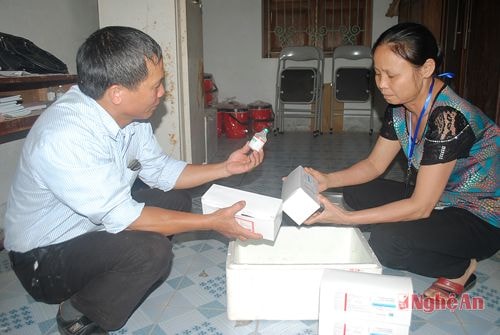Quality of the grassroots veterinary network - Part 1: Identifying the reality
(Baonghean) - Nghe An's Veterinary sector has yet to meet the requirements of livestock production in the new period. Many practical issues require early capacity improvement in all aspects such as organization, human resource development, building a grassroots veterinary network...
(Baonghean) - Nghe An's Veterinary sector has yet to meet the requirements of livestock production in the new period. Many practical issues require early capacity improvement in all aspects such as organization, human resource development, building a grassroots veterinary network...
Wide area; narrow perception!
Implementing the Resolution of the 17th Nghe An Provincial Party Congress, term 2010 - 2015, with the view of developing livestock farming according to the province's advantages, by 2015, it is expected that the pig herd will reach 1.15 million, poultry herd 17.5 million, buffalo herd 310 thousand, and cow herd 410 thousand. Up to this point (the last year of the term), all have exceeded the planned targets. In particular, the whole province has over 500 livestock farms, of which over 200 are buffalo and cow farms, raising an average of 35 - 40 cows or more, especially 2 farms with industrial scale, which are the dairy farm of TH Dairy Food Joint Stock Company raising over 18,000 dairy cows and Vinamilk dairy farm; There are over 189 pig and goat farms, each with 50 or more pigs, and many poultry farms, not to mention small-scale households.
 |
| Veterinary staff of Thach Son commune (Anh Son) vaccinate cows. |
The large herd, the number of farms, ranches and livestock households located in the area is large and complexly distributed, causing many difficulties for the state management of veterinary medicine in the area. In recent years, some localities have had low vaccination rates for livestock and poultry compared to the general level such as Hung Nguyen, Anh Son districts and some other mountainous districts in the West, greatly affecting the work of preventing and fighting epidemics and diseases. In addition to the objective difficulty of terrain as mentioned above, when contacting the localities, the main reason given is the lack of awareness of many livestock breeders.
We arrived in Anh Son district at the time when the locality was implementing vaccination against anthrax and spring cholera for buffalo, cows and pigs. Mr. Nguyen Xuan Ung, Head of the Veterinary Station of Anh Son district, said that as a "gateway" district of National Highway 7 to the Southwest of the province, trade has many advantages but also brings complications in the process of controlling epidemics and diseases of livestock and poultry. Previously, Anh Son district had many large epidemics, outbreaks on a large scale such as the foot and mouth disease in 2009, almost 21 communes and towns had infected livestock and caused serious consequences. The reason given was that a long time before, the vaccination rate for epidemics and diseases in the total herd was low, a large number of people were subjective, avoiding vaccination on livestock and poultry, while small-scale, fragmented, free-range farming was quite common, when the epidemic broke out, the rate of herd spread was very high, the time of infection was fast and it was difficult to control and suppress the epidemic.
However, it seems that this lesson is not enough to wake up a part of the people, because right at the peak of vaccination for livestock and poultry in the spring this year, although the announcement has been widely distributed and there is a vaccination schedule from the beginning of the year, many households are still indifferent, veterinary staff at the grassroots level have to go to each family to persuade and mobilize. Many households even drive buffaloes and cows up the mountains or into farms and ranches deep in the forest to hide, leaving only a few buffaloes and cows as "representatives" for vaccination. Not to mention, many households are still late, "making an agreement" with veterinary staff at the grassroots level, that they will pay for vaccination by the end of the year, if no epidemics occur!
Many other districts and towns are also facing similar situations. Que Phong district has 14 communes and towns, a large area with high mountains and steep passes, more than 90% of the population are ethnic minorities, and life still faces many difficulties. According to Mr. Nguyen Manh Cuong, Head of the Veterinary Station of Que Phong district: "The annual vaccination rate is quite low, averaging only about 50% of the total herd. In addition to objective reasons, the important thing is the subjective reasons from the people, causing many limitations in veterinary work in the area." Mr. Cuong added that the "reason" of some households is that epidemics rarely occur, and if they do occur, it is unlikely that they will hit their house! They also reason that vaccination costs money, but later, if livestock and poultry die from epidemics or diseases, the amount of money the State supports will not be equal to the value of the livestock (?!)...
Vaccination of livestock is both a duty and a right, but limited awareness causes a significant number of people to do it perfunctorily. This reality is causing great difficulties for vaccination of livestock and poultry in many areas of the province.
Human resources: Lack and weakness!
To develop livestock and poultry farming sustainably, the role of the grassroots veterinary team is very important. More than anyone else, they are directly present in the villages, hamlets, and hamlets every day to grasp and monitor the disease situation of livestock and poultry. When an epidemic occurs in livestock and poultry, they will promptly report and advise the local authorities on how to handle it. However, many localities are still taking this important "link" lightly.
 |
| Veterinarians of Tao Son commune (Anh Son) receive anthrax vaccine for the spring vaccination campaign. |
The fact that the grassroots veterinary team is both lacking and weak is a worrying reality in Anh Son district. Accordingly, in addition to the District Veterinary Station with a structure of 4 members, responsible for state management of veterinary work, in 21 communes and towns there are only 21 permanent veterinarians, and the number of freelance veterinary practitioners cannot be counted. According to Mr. Nguyen Xuan Ung, Head of the Anh Son District Veterinary Station, the reason why it cannot be counted is because the number of veterinary practitioners in the area fluctuates erratically, they are not bound by any obligations and responsibilities to the local government, so "if they like, they do it, if they don't like, they quit!" This situation has been going on for decades because the mechanism and policies for the grassroots veterinary team are too inadequate, they are completely not in the State's payroll, they do not even receive any monthly regime, because everything depends on the attention of the local government. Currently, there is only one commune veterinarian in charge of the local part-time staff system. According to Decision 14 of the Provincial People's Committee, people in this category are entitled to a subsidy of 0.8% of the minimum wage, equivalent to the actual amount received of 920,000 VND/month. In addition, there are no additional allowances.
For example, the entire Thach Son commune has 7 hamlets, over 1,100 buffaloes and cows, nearly 1,700 pigs and 2,500 poultry. The general manager of the total herd of livestock and poultry is Ms. Nguyen Thi Dan (64 years old), a veterinarian - a part-time commune official. She expressed her concerns during her 39 years of working in grassroots veterinary work: "Veterinary medicine is a toxic profession because it is often in contact with animal waste, polluted confinement and grazing environments, and dangerous because it comes face to face with aggressive animals when vaccinating and treating diseases, but for the past 39 years I have not had health insurance. The monthly allowance was from 20,000 VND in the 1980s and 1990s until early 2015 when I received 920,000 VND/month". She shared that she is now past the retirement age according to the State's regulations, her health has declined a lot, but she still tries to stick with the job for a while longer because the local government still has an offer for her to stay, and more importantly, if she quits, no one will take this job.
Veterinarians who are part-time commune cadres, despite facing many difficulties, still receive a small allowance that they secretly consider as “responsibility money” to stick with their work. As for the veterinary team in villages and hamlets, there is no allowance like Ms. Tran Thi Hoai, in hamlet 7, Thach Son, who has been practicing veterinary medicine for 33 years, and has been called almost every day. “Many times I was discouraged, and my family objected because it was too hard, so I thought about quitting the profession, but then because of the affection of the village, because of the thought “why would I learn a profession, have a profession but not treat the disease”, I packed my tools and left” – Ms. Hoai confided. Countless memories in 33 years of practice, such as being trampled by buffaloes and cows while getting vaccinated, having to be treated for years, getting infected wounds due to contact with waste and polluted environment…
Talking to us, Mr. Nguyen Xuan Hong, Chairman of the People's Committee of Thach Son commune, acknowledged the important role and responsibility of the grassroots veterinary team in the work of preventing and fighting animal diseases, but because the locality does not have funds, there is no source of support. During the annual vaccination campaigns, to encourage them to work, the commune has a policy of collecting wages for each vaccinated animal, at the rate of 5,000 VND/animal. That amount of money pays for the entire vaccination team, including 3 people in charge of: recording, arresting and vaccinating. The payment is low, so every vaccination period, the commune has a hard time finding human resources to do this work.
Not only is there a lack of human resources, but the quality of veterinary human resources at the grassroots level has been a problem for many years. Mr. Dang Van Minh, Deputy Head of the Provincial Veterinary Department, said that most of the people who currently work as veterinarians in localities are between 30 and 60 years old, most of whom have intermediate or primary veterinary qualifications from the 1980s and 1990s. Because they do not have a salary and receive little allowance, they are not active in their professional work. There have even been cases where this team intentionally hid the epidemic to treat and make money, only reporting it when the epidemic spreads, causing difficulties in organizing epidemic prevention and control.
Regarding the quality of human resources, of course, it is impossible not to take into account the factor of experience in the practice process, but along with the general development of the times, it requires high-quality human resources, sensitive access to advanced science and technology. Especially, in the context of the increasingly complicated epidemic and disease situation in livestock and poultry, the diagnosis, assessment of disease status and treatment regimens require high expertise and professionalism. The current situation of insufficient and weak veterinary human resources is posing many challenges for the provincial veterinary sector, requiring radical solutions and long-term strategies to contribute to the sustainable development of the livestock industry...
(To be continued)...
Xuan Hoang - Phuong Chi






